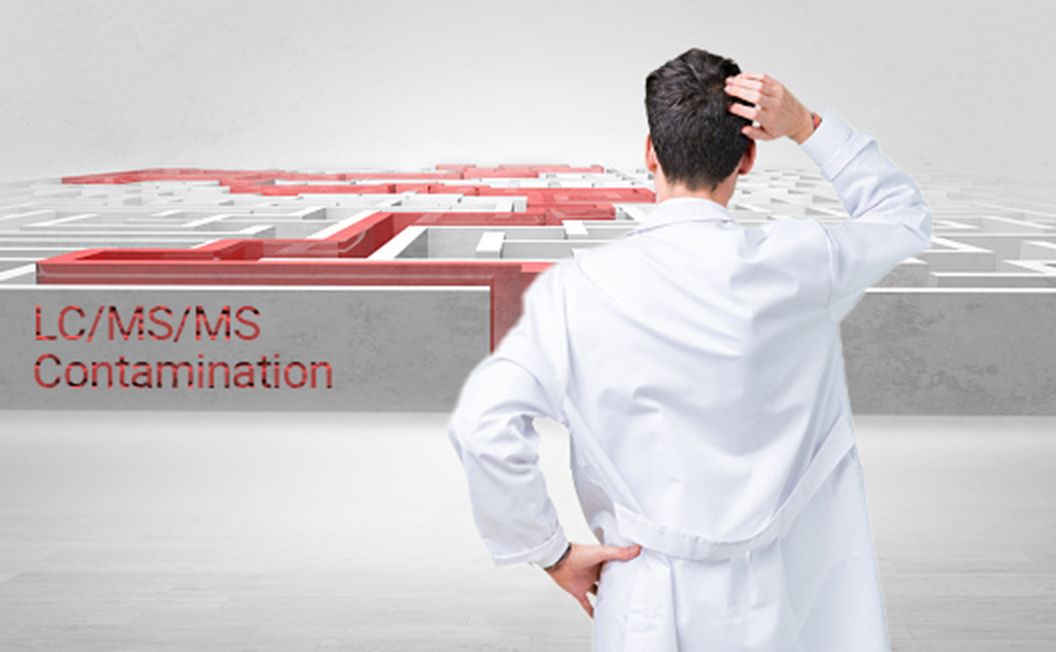Navigating the Labyrinth of LC/MS/MS Contamination
Triple-quadrupole mass spectrometry (LC/MS/MS) systems have seen substantial growth both in their capabilities and utilization. But even the most advanced systems are not immune to the challenges posed by contamination. We usually think that the inside of a mass spectrometer is a “clean” environment. Although these instruments are designed to minimize chances for contaminant reaction, these reactions can – and do – occur.
Understanding Contamination in LC/MS/MS Systems
Contaminants come in three distinct forms: chemical, physical, and biological. Chemical contaminants can arise from impurities in solvents or reagents, introducing unwanted substances that intertwine with our samples. Physical contaminants, often the result of improper sample handling or instrument maintenance, can manifest as debris, particles, or residue. The most elusive of the trio are biological contaminants, stealthily infiltrating analytical processes through microbial growth or cross-sample contamination.
Effects of Contamination
Compromised results affect the validity of experiments. Decreased sensitivity reduces the ability to detect low-concentration analytes. Ghost peaks materialize, confusing analysts with unexplainable signal spikes. Interference emerges, obscuring target analytes and leading to misinterpretations. As we go deeper into the labyrinth of contamination, it becomes evident that its effects are not confined to the laboratory but expand to the reliability and accuracy of analytical outcomes.
A Breakthrough in Contamination Management
For labs analyzing complex matrices, the PerkinElmer QSight® LC/MS/MS System offers a solution for contamination mitigation. The core innovation is StayClean™ Technology, designed to address matrix-induced contamination and minimize maintenance. This technology can potentially increase lab uptime up to 15%, which could equate to 35 extra days of operational time each year.
StayClean Technology comprises three key elements:
- Coaxial flow electrospray design: By preventing the dispersion of similarly charged particles, this 90° coaxial flow electrospray design improves ion sampling efficiency and sensitivity. The self-cleaning nature of the eluent further shields the system from contamination, reducing turbulent flow and ion fluctuations.
- Hot-surface-induced desolvation (HSID™) System: The HSID interface features a heated inner surface that deters contaminants from settling. A laminar flow gas envelops ions and solvated species, preventing collisions with the HSID walls and maintaining cleanliness. Solvated species undergo desolvation, resulting in uniform responses across the mass range without the need for lens optimization.
- Laminar Flow Ion Guide™ System: The HSID system emits a controlled ion/gas flux that traverses a series of pressure-reducing multipolar regions – the Laminar Flow Ion Guide system. This progression culminates in the ions entering the first mass filter at low pressure. The multipolar regions ensure ion containment, while the diminishing gas flux propels the ions forward. The background gas flow within the Laminar Flow Ion Guide funnels ions to the analyzing region, reducing reliance on axial electrical fields and yielding consistent performance. The result is a system less susceptible to fluctuations, eliminating instrument drift and the need for frequent reoptimization and cleaning.
In the world of analytical chemistry, contamination is a maze that analytical labs need to navigate to protect the accuracy and reliability of LC/MS/MS systems. Advancements such as the StayClean Technology present a practical solution to contamination-related challenges, while allowing labs to exploit their full productivity potential, even with complex matrices. Watch the video explaining how StayClean Technology works.
References:
- Kang, Y., Schneider, B.B. & Covey, T.R. On the Nature of Mass Spectrometer Analyzer Contamination. J. Am. Soc. Mass Spectrom. 28, 2384–2392 (2017). https://doi.org/10.1007/s13361-017-1747-3
- Contaminants Everywhere! Tips and Tricks for Reducing Background Signals When Using LC–MS, Published on: August 1, 2018, Dwight R. Stoll, LCGC North America, LCGC North America-08-01-2018, Volume 36, Issue 8, Pages: 498–504 https://www.chromatographyonline.com/view/contaminants-everywhere-tips-and-tricks-reducing-background-signals-when-using-lc-ms
- Ion Burn and the Dirt of Mass Spectrometry, Published on: September 1, 2010, Spectroscopy, Spectroscopy-09-01-2010, Volume 0, Issue 0, https://www.spectroscopyonline.com/view/ion-burn-and-dirt-mass-spectrometry

